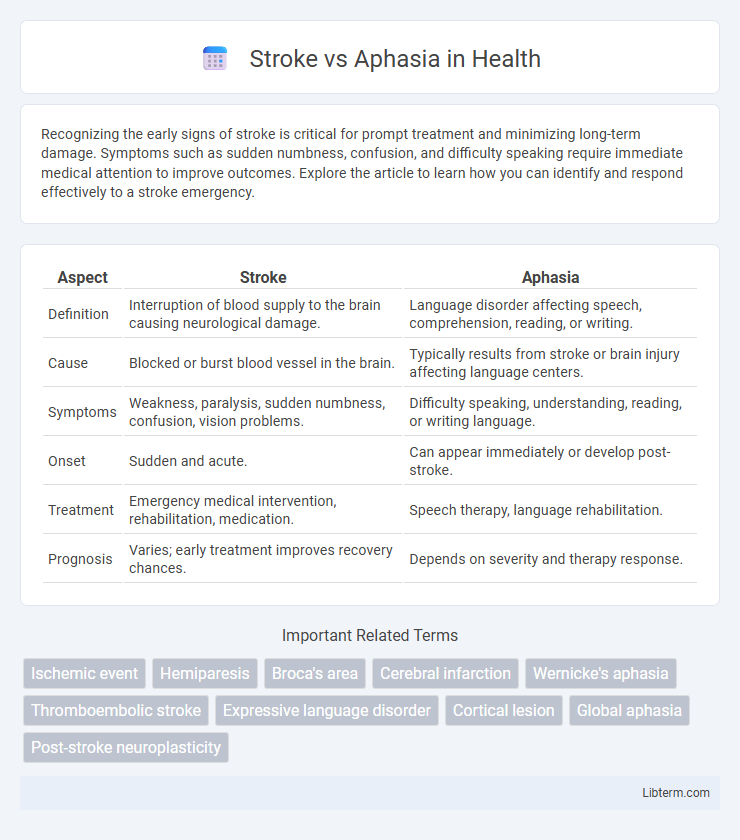Recognizing the early signs of stroke is critical for prompt treatment and minimizing long-term damage. Symptoms such as sudden numbness, confusion, and difficulty speaking require immediate medical attention to improve outcomes. Explore the article to learn how you can identify and respond effectively to a stroke emergency.
Table of Comparison
| Aspect | Stroke | Aphasia |
|---|---|---|
| Definition | Interruption of blood supply to the brain causing neurological damage. | Language disorder affecting speech, comprehension, reading, or writing. |
| Cause | Blocked or burst blood vessel in the brain. | Typically results from stroke or brain injury affecting language centers. |
| Symptoms | Weakness, paralysis, sudden numbness, confusion, vision problems. | Difficulty speaking, understanding, reading, or writing language. |
| Onset | Sudden and acute. | Can appear immediately or develop post-stroke. |
| Treatment | Emergency medical intervention, rehabilitation, medication. | Speech therapy, language rehabilitation. |
| Prognosis | Varies; early treatment improves recovery chances. | Depends on severity and therapy response. |
Understanding Stroke: Definition and Causes
A stroke occurs when blood flow to the brain is interrupted, causing brain cells to die due to lack of oxygen and nutrients. Common causes include ischemic stroke, resulting from blood clots obstructing arteries, and hemorrhagic stroke, caused by ruptured blood vessels leading to bleeding in the brain. Understanding these causes is crucial for timely diagnosis and effective treatment to minimize neurological damage.
What is Aphasia? Key Facts and Overview
Aphasia is a language disorder caused by damage to the brain areas responsible for speech and comprehension, commonly resulting from a stroke. Key facts include its impact on speaking, understanding, reading, and writing, while cognitive abilities remain largely intact. Aphasia severity varies, with types such as Broca's, Wernicke's, and global aphasia, each affecting language differently.
Stroke vs Aphasia: Core Differences
Stroke is a sudden neurological event caused by interrupted blood flow to the brain, leading to widespread or localized brain damage, while aphasia is a specific language disorder that often results from stroke damage, affecting speech, comprehension, reading, and writing abilities. Stroke can manifest in various forms like ischemic or hemorrhagic, impacting multiple brain functions beyond language, whereas aphasia specifically targets communication centers in the brain such as Broca's or Wernicke's areas. Understanding these core differences is essential for accurate diagnosis and tailored rehabilitation strategies to improve patient outcomes.
How Stroke Can Lead to Aphasia
Stroke, particularly ischemic or hemorrhagic types, causes brain damage by disrupting blood flow, often affecting the left hemisphere responsible for language processing. Damage to regions such as Broca's area or Wernicke's area results in aphasia, characterized by impaired speech production or comprehension. The severity and type of aphasia depend on the location and extent of the stroke-induced brain injury.
Common Symptoms of Stroke
Common symptoms of stroke include sudden numbness or weakness in the face, arm, or leg, especially on one side of the body, confusion or difficulty speaking and understanding speech, and sudden trouble seeing in one or both eyes. Other frequent signs are sudden dizziness, loss of balance or coordination, and severe headache with no known cause. Recognizing these symptoms promptly is critical for effective treatment and reducing the risk of long-term disability.
Common Symptoms of Aphasia
Aphasia commonly manifests after a stroke, affecting language abilities such as speaking, understanding, reading, and writing. Key symptoms include difficulty forming coherent sentences, frequent word-finding errors, and trouble comprehending spoken or written language. These language impairments vary depending on the stroke's location in the brain, particularly in areas like Broca's or Wernicke's regions.
Diagnosis: Stroke Compared to Aphasia
Stroke diagnosis primarily involves neuroimaging techniques such as CT scans and MRI to identify brain lesions or hemorrhages, while aphasia diagnosis focuses on a detailed speech and language assessment to evaluate communication impairments. Neurologists use the NIH Stroke Scale (NIHSS) for assessing stroke severity, whereas speech-language pathologists utilize standardized aphasia tests like the Western Aphasia Battery (WAB) or the Boston Diagnostic Aphasia Examination (BDAE). Imaging confirms the presence and location of brain damage in stroke, whereas aphasia diagnosis centers on characterizing the type and extent of language dysfunction resulting from brain injury.
Treatment Approaches for Stroke and Aphasia
Stroke treatment focuses on rapid medical intervention, including clot-dissolving medications like tPA for ischemic stroke and surgical procedures for hemorrhagic stroke to restore blood flow and minimize brain damage. Aphasia therapy centers on speech-language rehabilitation, utilizing techniques such as speech-language therapy, communication aids, and constraint-induced language therapy to improve language comprehension and expression. Combining stroke management with targeted aphasia treatment enhances recovery outcomes by addressing both neurological damage and language impairments.
Recovery and Rehabilitation: What to Expect
Stroke recovery involves regaining lost functions and can vary significantly depending on the severity and location of brain damage, with rehabilitation focusing on physical, occupational, and speech therapies. Aphasia, often resulting from stroke, requires targeted speech therapy to improve language skills such as speaking, understanding, reading, and writing, with progress influenced by the type and extent of language impairment. Consistent, personalized rehabilitation plans and early intervention increase the likelihood of significant recovery in both general stroke deficits and aphasia-related communication challenges.
Preventive Measures and Risk Factors
Stroke risk factors include hypertension, diabetes, smoking, and high cholesterol, all contributing to vascular damage and increasing the likelihood of a cerebrovascular event. Preventive measures emphasize controlling blood pressure, maintaining a healthy diet, exercising regularly, and avoiding tobacco use to reduce stroke incidence. Aphasia, often resulting from stroke-related brain injury, shares these preventive strategies by minimizing the severity and occurrence of stroke-induced language impairments.
Stroke Infographic

 libterm.com
libterm.com